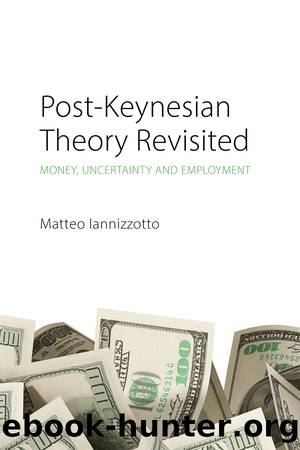Post-Keynesian Theory Revisited by Iannizzotto Matteo;

Author:Iannizzotto, Matteo;
Language: eng
Format: epub
Publisher: Agenda Publishing
Conclusion
It may seem that in discussing these points we have moved a long way away from the central theme of a monetary economy. A simple interpretation of the above may be that the existence of temporary idle balances in cash form prevents the attainment of full employment equilibrium, but that such disturbances are ultimately going to disappear as the retained cash is ultimately spent. That is misleading and false, however. Individual savings may indeed end up being spent but the saving of the economy as a whole never is in its entirety. This is yet another instance of the fallacy of composition against which post-Keynesian theory argues: the whole is more than the sum of its parts, and myopically focusing on the micro problem will never capture what the macro one actually is.
What the above implies is that the crucial variable the behaviour of which needs to be modelled in order to understand where the economy comes to rest is investment. This is the causa causans of the entire process, and a detailed examination of its determinants will inevitably lead us back to the quintessentially monetary nature of the economy.
The reason for this is neatly encapsulated in a single word: time. Production takes time, and investment in capital equipment most emphatically, because capital is a durable good that does not disappear from one period to the next but carries over, so that an addition to it, in flow terms, has to be understood by considering what its existing stock is at any point of time. But time inevitably brings into the picture one of the classical functions of money: that of a store of value. It is, as Keynes puts it, âa subtle device for linking the present to the futureâ (Keynes 1936: 294) â a future, needless to say, that is forever unknown and unknowable and therefore uncertain.
According to Marshall (see Landreth & Colander 1994: chap. 11), time was one of the most difficult issues in economics and one of the lines of enquiry of his theory that resurfaces, enhanced and given pride of place, in the works of his one-time pupil, Keynes, and his post-Keynesian followers. And it should also be stressed how much this constitutes a radical departure from the foundations of mainstream economics, which are primarily Walrasian. The general equilibrium of the economy in Léon Walrasâ system is inescapably timeless because everything must happen all at once, as necessitated by the equilibrium being defined as the outcome of a system of simultaneous equations. And âsimultaneousâ implies that the time dimension is assumed away at the outset. So, it is to investment and the time dimension that we now turn.
Download
This site does not store any files on its server. We only index and link to content provided by other sites. Please contact the content providers to delete copyright contents if any and email us, we'll remove relevant links or contents immediately.
International Integration of the Brazilian Economy by Elias C. Grivoyannis(91274)
The Radium Girls by Kate Moore(11921)
Turbulence by E. J. Noyes(7936)
Nudge - Improving Decisions about Health, Wealth, and Happiness by Thaler Sunstein(7615)
The Black Swan by Nassim Nicholas Taleb(7010)
Rich Dad Poor Dad by Robert T. Kiyosaki(6405)
Pioneering Portfolio Management by David F. Swensen(6226)
Man-made Catastrophes and Risk Information Concealment by Dmitry Chernov & Didier Sornette(5921)
Zero to One by Peter Thiel(5686)
Secrecy World by Jake Bernstein(4646)
Millionaire: The Philanderer, Gambler, and Duelist Who Invented Modern Finance by Janet Gleeson(4376)
The Age of Surveillance Capitalism by Shoshana Zuboff(4210)
Skin in the Game by Nassim Nicholas Taleb(4162)
Bullshit Jobs by David Graeber(4095)
The Money Culture by Michael Lewis(4076)
Skin in the Game: Hidden Asymmetries in Daily Life by Nassim Nicholas Taleb(3929)
The Dhandho Investor by Mohnish Pabrai(3699)
The Wisdom of Finance by Mihir Desai(3654)
Blockchain Basics by Daniel Drescher(3507)
